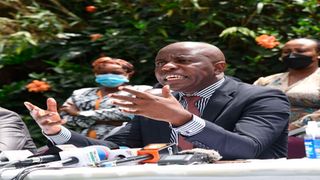
Caucus of MCAs chairman Victor Mutuma addresses a press conference on the High Court ruling on the Building Bridges Initiative (BBI), flanked by ward representatives from all the 47 counties, at Serena Hotel in Nairobi on May 16, 2021.
Politics
Premium
Public participation: BBI promoters did not involve Kenyans
In its judgement that nullified the Building Bridges Initiative (BBI) last week, the High Court made more than 113 references to the word “public participation”.
The court said the BBI exercise was constitutionally flawed because its promoters failed to involve Kenyans. The five-judge bench ruled that BBI proponents failed to distribute copies of the proposed amendments to the electorate to help them make informed decisions.
People with disabilities such as sight and hearing impairments were also excluded, the court ruled. In their decision, the judges compared the BBI process with the making of the 2010 Constitution where the committee that was undertaking the latter received more than 26,000 memoranda of divergent views from the public.
"Voters needed the copies in languages that they understand. The only copy annexed here was in English. No efforts made by the committee to make copies available for the public. People must be involved in the legislative process," said judges.
• So, what is Public Participation?
In ordinary language, the term is used to denote the involvement of the people in decision-making.
But it gets its legal legitimacy in the 2010 Constitution, which ushered in a new system of governance that places people at the centre. Article 118 mandates State organs or State officers seeking to make policies, regulations or even laws to conduct public participation.
This means all public processes, ranging from policy making, legislation and ultimate decision making, require the participation of the people.
• How is public participation conducted?
While the legal requirement is more than a decade old in Kenya, there is no law guiding the process.
In the early days after the promulgation of the Constitution in 2010, State officers and State organs had to devise their own ways of ensuring that the people were involved in formulation of laws, policy and decision-making.
A 2019 study by the Intergovernmental Relations Technical Committee established that the nature and extent of participation contemplated by the Constitution and the laws have not been achieved at both county and national government levels.
While a lot of public participation efforts have been made at both levels of government, the study found, there is no clarity on what constitutes adequate participation, the nature of the participation that meets the constitutional threshold, or the most effective mechanisms for public participation.
• Does it mean without the law the public participation has never been undertaken?
Being a critical component of the constitutional architecture, public participation has been undertaken before and in these cases, it was upon the State organs and State officers to devise ways of doing it.
However, at one point the courts were forced to step in to provide guidance, going to the extent of providing the threshold of what is meaningful public participation.
• So, what is the threshold of Public participation as set by the courts?
The public participation process must be qualitative rather than quantitative, according to courts. In other words, it is not the number of submissions that are made by stakeholders or the number of stakeholders that participate in such an exercise that matter. Further, State organs or State officers, when conducting public participation, should demonstrate they did engage, consider and examine the submissions made by the public in arriving at a decision.
• Why hasn’t Parliament made an attempt to make laws guiding public participation?
As a matter of fact, there are two bills before Parliament seeking to provide a legal mechanism on how the process will be conducted.





